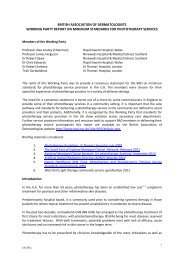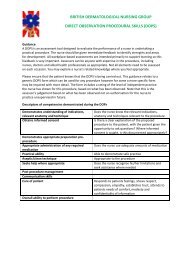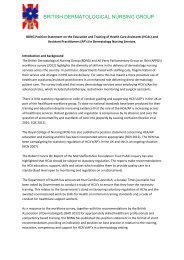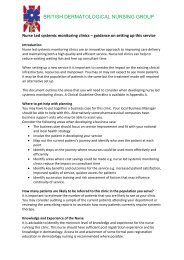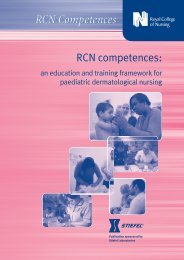Improving outcomes for people with skin tumours including melanoma
Improving outcomes for people with skin tumours including melanoma
Improving outcomes for people with skin tumours including melanoma
You also want an ePaper? Increase the reach of your titles
YUMPU automatically turns print PDFs into web optimized ePapers that Google loves.
<strong>Improving</strong> Outcomes <strong>for</strong><br />
People <strong>with</strong> Skin Tumours<br />
<strong>including</strong> Melanoma<br />
Organisation of <strong>skin</strong><br />
cancer services<br />
• Ensure that referring GPs are given prompt and full in<strong>for</strong>mation<br />
about their patients’ diagnosis or treatment in line <strong>with</strong> national<br />
standards on communication to GPs of cancer diagnoses.<br />
• Collect data <strong>for</strong> network-wide audit.<br />
Management of patients presenting in primary care<br />
The NICE Referral guidelines <strong>for</strong> suspected cancer 34 recommendations<br />
<strong>for</strong> <strong>skin</strong> cancer should be followed. These primarily relate to referral<br />
to a specialist in secondary care from a non-specialist GP.<br />
3<br />
Clinical guidelines have been published by the BAD and NICE <strong>for</strong><br />
management of NMSC and by the BAD, British Association of Plastic<br />
Surgeons, Melanoma Study Group and NICE <strong>for</strong> the management of<br />
MM. 35,36,37,38 The recommendations <strong>for</strong> management of specific tumour<br />
types in primary care are summarised in Figure 14 in the ‘Initial<br />
investigation, diagnosis, staging and management’ chapter and are<br />
consistent <strong>with</strong> these clinical guidelines. These clinical guidelines have<br />
also been included <strong>with</strong>in the Evidence Review.<br />
Structure and clinical governance<br />
All clinicians who see and plan to treat patients <strong>with</strong> <strong>skin</strong> cancer in<br />
the community should be approved by, and be accountable to, the<br />
LSMDT lead clinician, and work to agreed protocols.<br />
The work carried out should be audited on a regular basis and staff<br />
and resources made available <strong>for</strong> this. The LSMDT/SSMDT should be<br />
responsible <strong>for</strong> how these audits are organised and carried out. All<br />
doctors and nurses should have regular CPD and would be expected<br />
to attend the LSMDT/SSMDT meetings whenever one of their patients<br />
is being discussed, and at least four times a year. In addition,<br />
meetings to discuss audit results, guidelines and cancer measures<br />
should be arranged twice a year and all team members should attend<br />
these at least once year.<br />
34 National Institute <strong>for</strong> Health and Clinical Excellence. Referral guidelines <strong>for</strong> suspected<br />
cancer. Available from: www.nice.org.uk/CG027<br />
35 British Association of Dermatologists (1999) Guidelines <strong>for</strong> the management of basal cell<br />
carcinoma. Available from: www.bad.org.uk/healthcare/guidelines<br />
36 British Association of Dermatologists (2002) Multiprofessional guidelines <strong>for</strong> the<br />
management of the patient <strong>with</strong> primary cutaneous squamous cell carcinoma. Available<br />
from: www.bad.org.uk/healthcare/guidelines<br />
37 British Association of Dermatologists (2002) UK guidelines <strong>for</strong> the management of<br />
cutaneous <strong>melanoma</strong>. Available from: www.bad.org.uk/healthcare/guidelines<br />
38 National Institute <strong>for</strong> Health and Clinical Excellence. Referral guidelines <strong>for</strong> suspected<br />
cancer. Available from: www.nice.org.uk/CG027<br />
66<br />
National Institute <strong>for</strong> Health and Clinical Excellence




